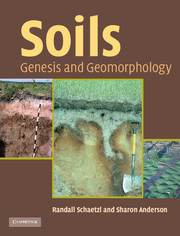Book contents
- Frontmatter
- Contents
- Preface
- Acknowledgements
- Part I The building blocks of the soil
- 1 Introduction
- 2 Basic concepts: soil morphology
- 3 Basic concepts: soil horizonation … the alphabet of soils
- 4 Basic concepts: soil mineralogy
- 5 Basic concepts: soil physics
- 6 Basic concepts: soil organisms
- 7 Soil classification, mapping and maps
- Part II Soil genesis: from parent material to soil
- Part III Soil geomorphology
- References
- Glossary
- Index
5 - Basic concepts: soil physics
from Part I - The building blocks of the soil
- Frontmatter
- Contents
- Preface
- Acknowledgements
- Part I The building blocks of the soil
- 1 Introduction
- 2 Basic concepts: soil morphology
- 3 Basic concepts: soil horizonation … the alphabet of soils
- 4 Basic concepts: soil mineralogy
- 5 Basic concepts: soil physics
- 6 Basic concepts: soil organisms
- 7 Soil classification, mapping and maps
- Part II Soil genesis: from parent material to soil
- Part III Soil geomorphology
- References
- Glossary
- Index
Summary
Soil physics is the branch of soil science that deals with the physical properties of soils. Included in this arena are the measurement, prediction and control of these physical properties, as well as the ways in which such knowledge facilitates various applications, e.g., irrigation scheduling. Just as physics deals with matter and energy, soil physics is generally concerned with the state and movement of matter and energy in soils.
Soil physical properties such as water content, texture and structure, as well as soil physical processes such as water retention and transport, soil temperature and heat flow, and the composition of the soil atmosphere (mainly O2 and CO2), all affect the rates of weathering and soil genesis. In this chapter we discuss the basic concepts of soil physics that are necessary as background to the more in-depth discussions of soil genesis and geomorphology that follow.
Soil water retention and energy
Many pedogenic process begin and end with the flow of water in soils (see Chapters 12 and 13). Water is the main agent by which solids and ions are transported within soils; knowledge of the forces acting upon water flow is, therefore, important to an understanding of soil genesis, not to mention soil use and management.
Water is retained in soils in two ways – in adsorbed and absorbed forms. Adsorbed water is retained on the surfaces of soil particles by chemical or physical binding, due to the natural adhesive attraction between water and solids.
- Type
- Chapter
- Information
- SoilsGenesis and Geomorphology, pp. 82 - 92Publisher: Cambridge University PressPrint publication year: 2005



